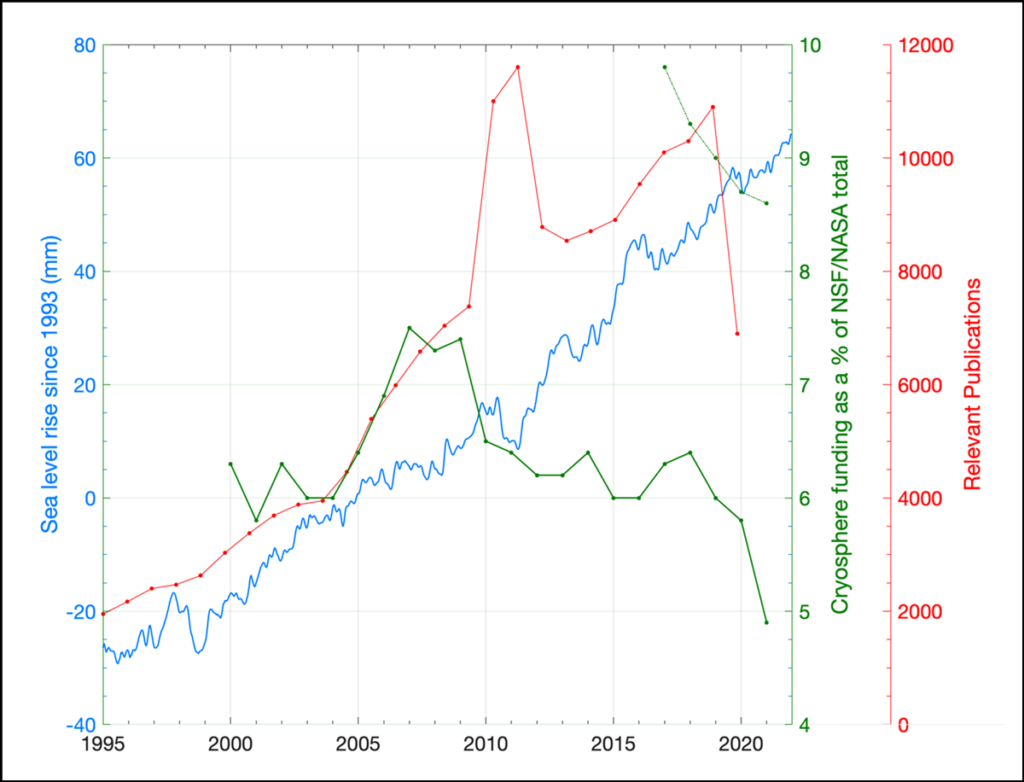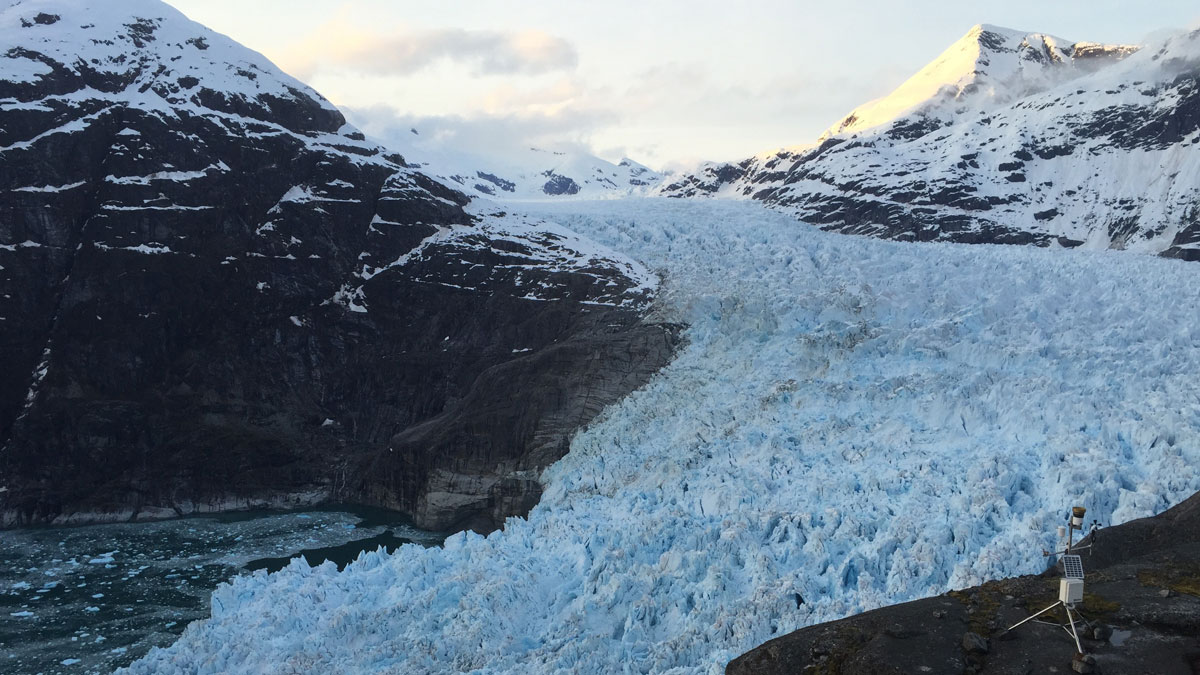Earth’s ice sheets and glaciers are responding rapidly to climate change. In the years and decades ahead, sea level rise, driven in part by melting ice, will affect millions of people in U.S. coastal communities and hundreds of millions more around the world. The cost of adaptation to sea level change along U.S. coastlines alone is expected to exceed $1 trillion by 2100 [Neumann et al., 2015].
Our ability to accurately and actionably project ice loss and its contributions to sea level rise requires glaciological knowledge and research coordination, as well as effective knowledge dissemination to decisionmakers, that are still unrealized. Current ad hoc efforts to meet these needs are inadequate, delaying the benefits of scientific research for many communities already grappling with increased coastal flooding and other impacts [Wing et al., 2022]. Through more coordinated planning and funding efforts, we can better serve these communities.
In addition to improving sea level projections relevant for coastal mitigation and adaptation responses, expanding our knowledge of glacial processes (including those influencing mountain glaciers) improves our understanding of how climate change affects agriculture, hydropower, drinking water, fisheries, and ecosystems. For example, research has revealed that mountain glacier retreat along the North American West Coast opens new habitat for Pacific salmon, affecting billion-dollar-per-year fisheries [Pitman et al., 2021]. It has also shown that the worldwide annual net loss of 240 billion metric tons of ice from mountain glaciers is comparable to 30% of annual water withdrawals used for industry and 63% of water withdrawals for domestic uses [Huss et al., 2017].
A great deal of glaciological knowledge has come about from a boom in glaciological research during the 2000s, which drew many new researchers to the field. Many of them are asking urgent questions prompted by the discovery that Earth’s ice sheets respond to environmental forcing on much shorter timescales than previously thought.
Critically, decades of glaciological research have provided huge advances toward improved prediction of sea level change. However, major gaps in glaciological understanding, observational data, and technical capacity persist and impede efforts to produce actionable predictions of ice loss directly linked to societal consequences (Figure 1). For example, we have only sparse observations from ice sheet boundaries, including the edges of marine-terminating glaciers and ice sheets where ocean currents influence ice loss. We lack a basic understanding of what happens between glacier ice and the underlying land, where topography, sediments, and subglacial water influence ice motion. We also lack sufficient long-term monitoring of climate conditions that are forcing ice sheet change, including ocean heat content, which was recently recognized as critically important to both the Greenland and Antarctic ice sheets.

Despite the serious implications of coastal inundation and other ice loss impacts, research on Earth’s glaciers and ice sheets remains a low funding priority in the U.S. scientific enterprise (Figure 2) [Aschwanden et al., 2021]. This low standing is not for a lack of identifying critical scientific problems or their societal relevance. Indeed, the knowledge gaps noted above have been identified in numerous published studies and are well known to the scientific community [e.g., Catania et al., 2020; Hock et al., 2017; Noble et al., 2020; Straneo et al., 2019], federal and international funding agencies, and scientific organizations. Instead, we perceive other shortcomings that stymie innovation in glaciology and its contributions to accurate projections of ice loss and, by extension, U.S. resilience to sea level.

Culture, Curriculum, Organization, and Funding
Glaciology suffers cultural shortcomings common across the geosciences, specifically a historic and ongoing lack of gender, ethnic, and racial diversity.
Glaciology suffers cultural shortcomings common across the geosciences [Bernard and Cooperdock, 2018; Dutt, 2020], specifically a historic and ongoing lack of gender, ethnic, and racial diversity that makes the discipline inequitable. Part of this problem arises because popular conceptions of glaciology are rooted in hero-glorifying expeditions led by a small number of individuals, while the contributions of many others in the field go underrecognized. This conceptualization narrows the range of visible role models, reduces chances for diversity benefits within our field, creates a tone of elitism and exclusivity, and is unethical.
This culture makes it difficult for minoritized researchers (demographic groups relegated to a subordinate status, regardless of their actual numbers) to enter the field, contribute productively, and be valued and evaluated fairly, resulting in the near-complete exclusion of these researchers from glaciology. The lack of diversity also means that decisionmaking and organization within the scientific community are not inclusive, making community consensus on research priorities more difficult. The glaciology community must actively participate in emerging initiatives that are promoting equity in the geosciences, such as URGE (Unlearning Racism in Geoscience) and Polar Impact, and institutions and funders should reinforce the necessity of self-education about cultural issues in science across career levels, including for established scientists.
There has been a hiring boom in glaciology within the past half decade in the United States, indicating that academia recognizes the field as an important research area. However, this hiring boom is concentrated in a relatively small number of institutions, with many U.S. universities still lacking research on the cryosphere entirely. Further, an emphasis on the cryosphere has not yet been integrated into undergraduate geoscience curricula uniformly, obscuring the discipline’s importance for many emerging scientists. Together with a lack of diversity, this lack of exposure translates into fewer students pursuing cryosphere science than are needed, inequitable representation in the research workforce, and generally less understanding of the importance of Earth’s cryosphere among the public.
Progress in glaciology also suffers from insufficient funding from federal science agencies. Federal funding for non-defense-related research and development overall dropped from 5.8% of the federal budget in 1966 to 1.5% in 2019. And no U.S. science agency funds long-term (5+ years) glacier or ice sheet investigations except the U.S. Geological Survey (USGS), via its Benchmark Glacier Project, which has been funded by a patchwork of USGS grants since 1958.
There is no coordinating federal body with a sufficient budget, schedule, or scope to focus glaciological research on reducing uncertainty in future sea level projections.
Within the National Science Foundation (NSF), glaciology has no home outside of the Office of Polar Programs (OPP), in contrast to other fields like atmospheric sciences, oceanography, and Earth sciences that are supported by OPP and other programs. NSF therefore lacks the capacity to fund science on midlatitude and tropical glaciers that lie between 60°N and 60°S latitude. Furthermore, in the past 5 years, funding for OPP has dipped to less than 6% (<$500 million) of the total NSF research budget (Figure 2), and only one third of the OPP budget goes to research because of the high costs of supporting polar logistics. This limited amount is then spread across all 10 disciplines working in the polar regions. Assuming an equal split across all 10, the maximum annual amount that glaciology could receive is approximately $10 million, about 10% of the average cost of a U.S. blockbuster movie. Available funding data from NASA are more limited, yet there has been a proportional decrease there as well: Funding for Earth science research, which includes cryosphere studies, dropped from nearly 10% of the total NASA budget in 2017 to 8.5% in 2021.
The shortage of funding for glaciology hurts the United States’ ability to prepare adequately for coming changes in water availability for hydropower and general use from vital western U.S. and Alaska glaciers. Further, there is no coordinating federal body with a sufficient budget, schedule, or scope to focus glaciological research on reducing uncertainty in future sea level projections. The only federally funded program dedicated to studying sea level is NASA’s Sea Level Change Team, which means that scientific problems outside NASA’s domain of expertise are researched ad hoc. Such investigations are driven and prioritized by the interest and funding of individual principal investigators rather than by needs identified through research coordination.
Working Together to Build Resilience
The study of our changing glaciers and ice sheets is a critical part of the tapestry of geoscience solutions needed to address 21st century problems like sea level change. Unfortunately, social and organizational shortcomings, along with the low prioritization of funding for glaciology in the United States, have left enormous knowledge gaps, making it much more difficult for scientists to provide the best possible projections of ice loss and local-scale impacts to decisionmakers responsible for planning responses to these problems.
We envision improved cross-agency organization and funding leading to a more comprehensive understanding of glacial processes and ice loss across the entire globe. Although cryosphere researchers gather to present research at many annual venues, we rarely meet to discuss future research priorities. Given the current funding landscape, we propose holding regular, open discussions to facilitate deeper reflection on the critical research needed. Within these meetings, glaciologists must debate, decide on, and then disseminate near- and long-term research priorities for funding that focus on vital observational, knowledge, and modeling gaps. These priorities should include long-term programs to monitor the climate conditions affecting ice sheets, observational programs aimed at improving our understanding of outlet glacier terminus and basal processes, and intensified ice sheet model development to integrate these observational efforts.
Reducing resource scarcity and improving cross-agency organization can accelerate a shift from competitive, isolationist tendencies to collaborative work that promotes rapid progress toward filling glaciological knowledge gaps.
We also argue for additional funding for glaciological research. Purposeful, successful investments in such work, scaled to match the high stakes of rising sea levels and other consequences of ice loss, are possible. NASA’s recently completed airborne mission Operation IceBridge is one example of how such investment can yield significant results. IceBridge spanned the observational gap between the ICESat (2003–2009) and ICESat-2 (launched in 2018) satellite missions to survey Earth’s rapidly changing icescapes across the Arctic and Antarctic [MacGregor et al., 2021]. New data collected during IceBridge revolutionized how researchers understand ice sheet behavior and provided necessary data on ice volume loss. Another example is the International Thwaites Glacier Collaboration, which has provided collaborative international funding and logistical support to investigate one of the most difficult to study and highly changeable parts of Antarctica.
Reducing resource scarcity and improving cross-agency organization can accelerate a shift from competitive, isolationist tendencies to collaborative work that promotes rapid progress toward filling glaciological knowledge gaps. Glaciologists are largely siloed within their universities, and the current funding environment incentivizes them to remain siloed to protect their research and gain an edge in the hypercompetitive grant proposal arena. More funding opportunities would reduce this competition and the incentives to operate alone. Cross-agency funding initiatives—involving NASA, NSF, NOAA, USGS, the Army Corps of Engineers, and the Department of Defense—focused on sea level science are needed to
- motivate collaboration among glaciologists and between glaciologists and researchers in other disciplines
- provide critical support for observational studies, monitoring, and modeling of ice sheets and coastal change
- support coordination between sea level scientists and policy specialists and others in government, nongovernment, and industry organizations who are knowledgeable about how to apply sea level science for societal concerns [Ultee et al., 2018]
Glaciologists dedicate their careers to advancing understanding of the physical processes controlling glaciers and ice sheets—work that vitally informs projections of sea level as well as other potential impacts of ice loss on ecosystems and human well-being. With improved organization and increased financial resources, current research and monitoring can seed expanded efforts that will help the United States fill significant gaps in scientific understanding and build resilience to the consequences of ice loss for the entire world.
Acknowledgments
The authors thank the members of the glaciology research community who have agreed with the opinions expressed in this article by signing their names to this hyperlinked list. We also thank Caitlyn Florentine for initiating the conversation and being part of the many helpful discussions that led to the publication of this article.
References
Aschwanden, A., et al. (2021), A roadmap towards credible projections of ice sheet contribution to sea level, Cryosphere, 15, 5,705–5,715, https://doi.org/10.5194/tc-15-5705-2021.
Bernard, R. E., and E. H. G. Cooperdock (2018), No progress on diversity in 40 years, Nat. Geosci., 11, 292–295, https://doi.org/10.1038/s41561-018-0116-6.
Catania, G. A., et al. (2020), Future evolution of Greenland’s marine-terminating outlet glaciers, J. Geophys. Res. Earth Surf., 125(2), e2018JF004873, https://doi.org/10.1029/2018JF004873.
Dutt, K. (2020), Race and racism in the geosciences, Nat. Geosci., 13, 2–3, https://doi.org/10.1038/s41561-019-0519-z.
Hock, R., J. K. Hutchings, and M. Lehning (2017), Grand challenges in cryospheric sciences: Toward better predictability of glaciers, snow and sea ice, Front. Earth Sci., 5, 64, https://doi.org/10.3389/feart.2017.00064.
Huss, M., et al. (2017), Toward mountains without permanent snow and ice, Earth’s Future, 5(5), 418–435, https://doi.org/10.1002/2016EF000514.
MacGregor, J. A., et al. (2021), The scientific legacy of NASA’s Operation IceBridge, Rev. Geophys., 59(2), e2020RG000712, https://doi.org/10.1029/2020RG000712.
Neumann, J. E., et al. (2015), Joint effects of storm surge and sea-level rise on US coasts: New economic estimates of impacts, adaptation, and benefits of mitigation policy, Clim. Change, 129, 337–349, https://doi.org/10.1007/s10584-014-1304-z.
Noble, T. L., et al. (2020), The sensitivity of the Antarctic ice sheet to a changing climate: Past, present, and future, Rev. Geophys., 58(4), e2019RG000663, https://doi.org/10.1029/2019RG000663.
Pitman, K. J., et al. (2021), Glacier retreat creating new Pacific salmon habitat in western North America, Nat. Commun., 12, 6816, https://doi.org/10.1038/s41467-021-26897-2.
Straneo, F., et al. (2019), The case for a sustained Greenland Ice Sheet–Ocean Observing System (GrIOOS), Front. Mar. Sci., 6, 138, https://doi.org/10.3389/fmars.2019.00138.
Ultee, L., et al. (2018), From ice sheets to main streets: Intermediaries connect climate scientists to coastal adaptation, Earth’s Future, 6(3), 299–304, https://doi.org/10.1002/2018EF000827.
Wing, O. E. J., et al. (2022), Inequitable patterns of US flood risk in the Anthropocene, Nat. Clim. Change, 12, 156–162, https://doi.org/10.1038/s41558-021-01265-6.
Author Information
Ginny Catania ([email protected]), University of Texas at Austin; Twila Moon, University of Colorado Boulder; and Andy Aschwanden, University of Alaska Fairbanks


